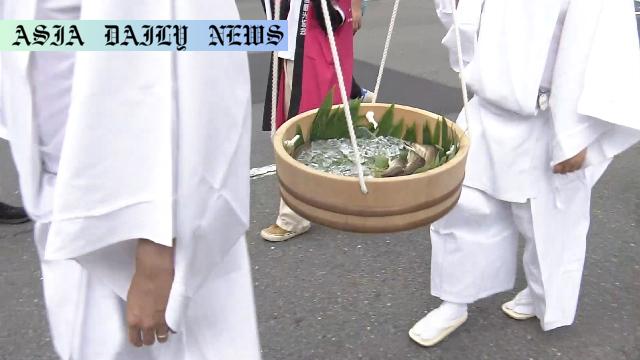Hamo Pike Eel – A parade to deliver seasonal ‘hamo’ eels to Yasaka Shrine marks Gion Festival, celebrating Kyoto and Awaji Island’s bond.
- The annual ceremony marks an ancient practice of offering marine delicacies.
- Around 80 participants parade to Yasaka Shrine, honoring tradition.
- Hamo pike eels highlight the cultural bond between Kyoto and Awaji Island.

Introduction: Celebrating Kyoto’s Rich Heritage
Every year, Kyoto becomes the heart of cultural celebrations as the Gion Festival, one of Japan’s most historic and vibrant festivals, unfolds. This month-long affair features a unique and visually striking tradition—the delivery of fresh ‘hamo’ pike conger eels to Yasaka Shrine. This offering reflects a blend of spirituality, gastronomy, and deep cultural heritage. The custom, rooted in history, also highlights a strong connection between Kyoto and Awaji Island in Hyogo Prefecture, an area renowned for cultivating this prized fish delicacy.
Understanding the significance behind this offering requires delving into Kyoto’s cultural tapestry and the unique role Awaji Island has played in shaping the culinary and spiritual practices of the region. By passing down this tradition through generations, the event is a vivid reminder of how festivals bring history to life in modern times.
An Ancient Practice Brought to Modern Times
The inspiration for this ceremony finds its roots in an ancient practice where marine products, including hamo, were presented to the Imperial Court as a token of respect and spiritual offering. Awaji Island’s position in the Seto Inland Sea once made it crucial in providing Kyoto with seafood. Today, this connection is commemorated during the Gion Festival as representatives from Awaji Island’s tourist association lead a parade to present the pike conger eel at the altar of Yasaka Shrine.
Participants—around 80 people including officials and volunteers—played a significant role in continuing this tradition. Donning traditional attire, the individuals carried a specially crafted tub filled with three hamo pike eels. This ceremonial journey is more than a simple parade; it is a reenactment of history, paying homage to the link between Kyoto’s cultural significance and nature’s bounty.
The Ritual at Yasaka Shrine
Once the parade reached Yasaka Shrine, the hamo were offered to the shrine’s Shinto deities. The altar, adorned with symbols of Japanese spirituality, stood as a testament to harmony between nature, religion, and human communities. Participants engaged in a purification ritual, praying for wellness, prosperity, and relief from the summer heat.
Interestingly, the tradition goes beyond spiritual practices. Guests visiting the shrine were treated to eel-based dishes, embodying the culinary importance of hamo. Renowned for its ability to thrive during the summer, this delicacy remains not only a cultural symbol of Kyoto but also a practical choice for summer sustenance.
Cultural and Economic Significance
This event showcases Kyoto’s ability to celebrate its heritage artistically while strengthening its relationship with tourist stakeholders like Awaji Island. Kinoshita Manabu, the head of Awaji Island’s tourist association, emphasized the symbolic importance of the ceremony. He noted that successful eel harvests this year enabled a seamless continuation of this long-standing tradition, further embedding strength between Kyoto and Awaji cultures.
The Gion Festival and its accompanying ceremonies also contribute economically to the region. As tourists flock to witness these vibrant spectacles, Kyoto and its neighboring areas see a boost in food and tourism-based revenues, showcasing how cultural heritage plays a vital role in local economies.
Conclusion: Preserving Traditions for Future Generations
The hamo pike eel offering parade is more than a ritual; it is a tapestry of history, culture, and spirituality woven together. The dedication of Awaji Island’s representatives and Kyoto’s inhabitants to preserving and promoting their heritage ensures that future generations continue to honor these timeless traditions. Offering gratitude to nature through such ceremonies reminds people of the region’s delicate balance of natural resources and cultural identity. The Gion Festival, and in particular the hamo offering, serves as an inspiring reflection of how past practices can evolve into impactful modern traditions.



Commentary
The Beauty of Heritage in Modern Times
There is something profoundly meaningful about the hamo pike eel offering parade in Kyoto. It exemplifies how historical traditions can remain relevant in today’s rapidly changing world. What struck me the most about this event was how rooted it is in the balance between people, nature, and spirituality. The offering of seasonal delicacies, like the hamo pike eel, not only honors ancient deities but also celebrates the bounty of nature and cultivates gratitude among the community.
Fostering Connections Across Regions
What makes the hamo offering particularly special is the connection it fosters between Kyoto and Awaji Island. At a time when the world can seem increasingly fragmented, it’s inspiring to see cultural events like this bringing communities together. Awaji Island’s dedication to providing these prized fish year after year reinforces a sense of partnership and pride. The relationship between the two regions is one of mutual appreciation and interdependence, demonstrating how geography can shape cultural and economic bonds over centuries.
Tradition as a Tool for Future Growth
The popularity of the Gion Festival and its related practices, such as the hamo offering, also serves a practical purpose. These events showcase the vibrancy and depth of Japanese culture while drawing in both domestic and international tourists. They remind us that traditions, far from being outdated, can be powerful vehicles for modern-day economic and cultural growth. However, alongside celebration comes responsibility. Preserving these traditions requires effort, resources, and the meticulous passing of knowledge to future generations.
Overall, the hamo pike eel parade to Yasaka Shrine stands as a remarkable example of how culture and community work together to sustain traditions. These efforts ensure that such meaningful practices remain an enduring legacy of Japan’s rich heritage.